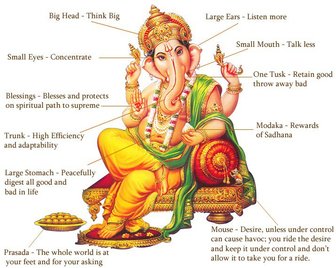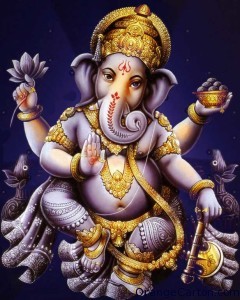Well, it’s true that right trunked ganesha idols are not perfect for gifting or home. But, that does not mean, you have to completely avoid buying right trunked idols. If you are prepared to perform the required rituals, you can even keep this idol in your pooja room.
In this post, we will discuss the significance and solutions to keep right-trunked ganesh idols. But, before getting in to details, let us see what the trunk direction actually means.
The Meaning of Ganesha’s Trunk Direction

Did you know, different parts of lord ganesha represent different things in life?
For instance, the large elephant head symbolizes intelligence, wisdom and strength of mind one must possess to tackle the problems arising in life.
The large belly corresponds to the vigor one should hold to digest all good and bad things in the world.
The trunk represents the adaptability and efficiency one should possess to handle all worldly problems.
It does not end there. The trunk direction also has hidden meanings.
In fact, there are three beliefs on ganesha’s trunk direction and all of them say the same – the right trunked ganesh idols are stronger, powerful and are difficult to worship.
Let’s see what these beliefs are.
1. It’s believed that Ganesha idols with trunk turning to left side is generally calm because, it’s the direction of moon channel (Ida Nadi) – the spiritual energy channel corresponding to soothing energy flow. This channel caters to left sympathetic nervous system that looks after one’s emotional life.
Conversely, the right trunked Ganesha idols are more powerful since the trunk is turning towards south, or sun channel (Pingala Nadi) that is analogous to lively energy flow. This channel corresponds to the right sympathetic nervous system that takes care of supra-conscious mind. Thus, the idols with trunk towards right are said to be aggressive and demanding.
2. There is also another notion on trunk direction. According to this belief, a body has two personalities, a feminine and masculine side. The left side of the body is feminine and right side masculine.
The left side represents the easy going, serene nature of a person and are ideal for fetching good luck, fortune and calmness to ones life. The right side, however is hostile and represents the angry self of the person. As a result, the right trunked ganeshas are said to be masculine and challenging to worship.
3. As per third belief, the right trunked ganesha is a dakshin abimukhi ganesha (facing southern direction) and in Hindu religion, everything towards south is bad luck. As indicated by religious texts, this is the direction of Lord Yama, the god accountable for death and suffering.
 So, if a God can face the direction of Lord Yama, he must be a dominant god, right? Well, that’s what this belief says — right trunked ganeshas are more powerful and you won’t be able to worship or please him the way you do the left trunked versions.
So, if a God can face the direction of Lord Yama, he must be a dominant god, right? Well, that’s what this belief says — right trunked ganeshas are more powerful and you won’t be able to worship or please him the way you do the left trunked versions.
As result of such powerful presence, right trunked ganeshas are usually called “Siddhi-Vinayak” (meaning vinayak with supernatural powers).
You can see dominance of these powerful Ganeshas, when you visit any of the right trunked ganesha temples. You will also notice the difference in rituals there.
So, what can we learn from here? Just like human beings, if you are trying to please a god, you should worship the calmer version (left trunked) than the hostile version.
And what about gifting right-trunk ganeshas? Should you gift? I trust it should be clear to you that because of all these reasons, it’s not recommended to gift right trunked Ganesh idols. Your recipient might not have enough knowledge about these types of idols. So, to be on the safer side, it’s good to avoid right trunked ganeshas.
But, what if you already have such idols in your home? Can you keep it in your pooja room?
 I believe, it must be evident to you by now that right trunked ganesh idols require strict and demanding pooja rituals. Is it a good idea to keep such challenging idols in your pooja room? Of course not, especially, if you are unable to perform the rituals on a regular basis.
I believe, it must be evident to you by now that right trunked ganesh idols require strict and demanding pooja rituals. Is it a good idea to keep such challenging idols in your pooja room? Of course not, especially, if you are unable to perform the rituals on a regular basis.
So, what’s the solution? The answer is simple – just keep them outside your pooja room.
When you keep these idols out of pooja room, you are not worshiping them. You are just using it as a home decor accessory. In that case, these ganeshas are dormant and won’t cause any harm. Your luck is undamaged!
On the other hand, if you were worshiping them in your pooja room and are unable to perform the required rituals, you must donate it to temples or you should perform visarjan in a river (…because an idol kept in pooja room might have gained consciousness).
In short, if you are worshiping right trunked ganesha, be prepared to spend time regularly on the rituals. Otherwise, keep them as home décor and ensure you will never have any kind of worship towards them.
Now let us see how you can actually worship a right trunk ganesha.
How to Worship Ganesh with Right Trunk?
 As mentioned earlier, the rituals for right-trunked ganesha is different from that of left-trunked ganesha. Here is how you can worship right trunk ganesha idols.
As mentioned earlier, the rituals for right-trunked ganesha is different from that of left-trunked ganesha. Here is how you can worship right trunk ganesha idols.
Before ganesha pooja, gather these things ready: flowers (or garland) , red sandalwood paste (kumkum), rice grains, sweets, water, diyas, ghee, incense sticks and campher.
First, prepare your pooja mandir for Ganesha worship. It must be clean and free from dirt. Clean the ganesha idol with a wet cloth. Place him on the raised mandap. Dress him the way you usually do.
Now, meditate a peaceful ganesha in your mind. Think about a happy ganesha you can imagine. Chant this mantra during meditation:
Gajaananam Bhootaganaadi Sevitam
Kapittha Jamboo Phalasaara Bhakshitam
Umaasutam Shoka Vinaasha Kaaranam
Namaami Vighneshwara Paada Pankajam
Now, invite lord ganesha to accept your worship by chanting this mantra: Om Gam Ganapataye Namah twelve times. It is believed that, when you chant this mantra, the idol would gain consciousness.
Next Step: light diyas and lamps in your pooja mandir. During the whole time, you can chant this mantra: Om Shri Ganeshaye Namah.as many times you feel.
After that, you can start giving your offerings one by one to Lord Vinayak.
First offer him water three times. Then offer rice grains three times. Then offer sweets three times. And finally, offer water again three times. Now, Ganesha is well fed and is ready to accept your prayers.
Next, offer him the holy mark on his forehead with red sandalwood paste. Then, worship him with flowers or garlands.
Once that’s complete, praise ganesha with his famous 12 names.
- Om Sumukhaaya Namah
- Om Ekadantaaya Namah
- Om Kapilaaya Namah
- Om Gaja Karnakaaya Namah
- Om Lambodaraaya Namah
- Om Vikataaya Namah
- Om Vighna Raajaaya Namah
- Om Ganaadhipataye Namah
- Om Dhoomaketave Namah
- Om Ganaadhyakshaaya Namah
- Om Phaalachandraaya Namah
- Om Gajaananaaya Namah
Now, it’s the time to offer incense sticks. Take a couple of agarbatti sticks and light them up. Then circle the idol 3 or 5 times in clockwise direction.
Once that is done, prepare yourselves to perform aarti. You can also light camphor now. Take the lamp in your hand and circle the idol three or five times in clockwise direction. During this time, sound the bells and chant this mantra as many times you feel:
Om Namo Siddhivinayakaay Sarvakaryakartrey Sarvavighanprashamnay Sarvarjya Vashyakarnaay Sarvajan Sarvastree Purushakarshanaay Shreeng Om Swaha
After this, fold your hand (as Namaste) and offer your inner prayers. With this step, pooja is over and you can distribute prasad to other people in your home.
(Please note the above-mentioned pooja is a truncated pooja ritual for your home; if you are looking for a detailed method, please consult with your local priest.)
It’s recommended that you do this pooja twice daily for best results. If you are unable to do twice, make sure you do the pooja in morning.
So, there you are! This is how you worship right trunked ganesh idols. As you can see, if you have the will do the rituals, you don’t have to worry about keeping right trunked ganesh idols in your pooja room. Just worship Ganesh in the correct way and you will live a happy and prosperous life.